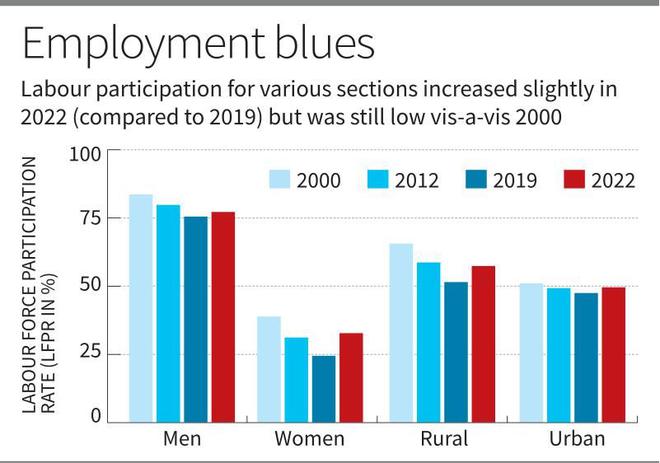India’s youth account for almost 83% of the unemployed workforce and the share of youngsters with secondary or higher education in the total unemployed youth has almost doubled from 35.2% in 2000 to 65.7% in 2022, as per the India Employment Report 2024 released by the International Labour Organisation (ILO) and the Institute of Human Development (IHD) here on Tuesday. The youth employment and underemployment increased between 2000 and 2019 but declined during the pandemic years, the study, released by Chief Economic Adviser V. Anantha Nageswaran, said, adding that educated youths have experienced much higher levels of unemployment in the country during the period.
The Labour Force Participation Rate (LFPR), Worker Population Ratio (WPR) and the Unemployment Rate (UR) showed a long-term deterioration between 2000 and 2018, the study said but witnessed an improvement after 2019. The study added that the improvement coincides with periods of economic distress, both pre and post-COVID-19 with the exception of two peak COVID-19 quarters. “This improvement needs to be interpreted cautiously as jobs generated in the slowdown period raise questions about the drivers of these changes,” the authors of the report said during the release.

Paradoxical improvements
The report said India’s job story over the past two decades had seen some paradoxical improvements in labour market indicators, while the basic long-term feature of the employment situation in the country continued to be insufficient growth of the non-farm sectors and the ability of these sectors to absorb workers from agriculture. “This is notwithstanding the fact that non-farm employment grew at a higher rate than farm employment over the different periods prior to 2018,” the report said. Labour from agriculture was mainly absorbed by the construction and services sectors.
Also, almost 90% of workers remain engaged in informal work, while the share of regular work, which steadily increased after 2000, declined after 2018. There are widespread livelihood insecurities, the report added, with only a small percentage being covered with social protection measures, precisely in the non-agriculture, organised sector. “Worse, there has been a rise in contractualisation, with only a small percentage of regular workers covered by long-term contracts,” the report said. While India’s large young workforce is a demographic dividend, the report noted that they don’t appear to have the skills to deliver — with 75% of youth unable to send emails with attachments, 60% unable to copy and paste files, and 90% unable to put a mathematical formula into a spreadsheet.
Widening gender gap
The lack of quality employment opportunities is reflected in the high level of joblessness among young people, especially among those who have achieved higher education, the report noted. “Many highly educated young people are unwilling to take on low-paying, insecure jobs that are currently available and would rather wait in the hopes of securing better employment in the future,” the study said. The country is also facing the challenge of a substantial gender gap in the labour market, with low rates of female labour force participation. “The unemployment challenge among young women, especially those who are highly educated, is enormous,” the report said.
Also read: How big is the gender gap in earnings?
Throwing light on the growing social inequalities, the report said despite affirmative action and targeted policies, the Scheduled Castes and Scheduled Tribes still lag in terms of access to better jobs. “Scheduled Castes and Scheduled Tribes have greater participation in work due to economic necessity but engaged more in low-paid temporary casual wage work and informal employment,” it said. “Despite improvement in educational attainment among all groups, the hierarchy within social groups persists,” the report added.







